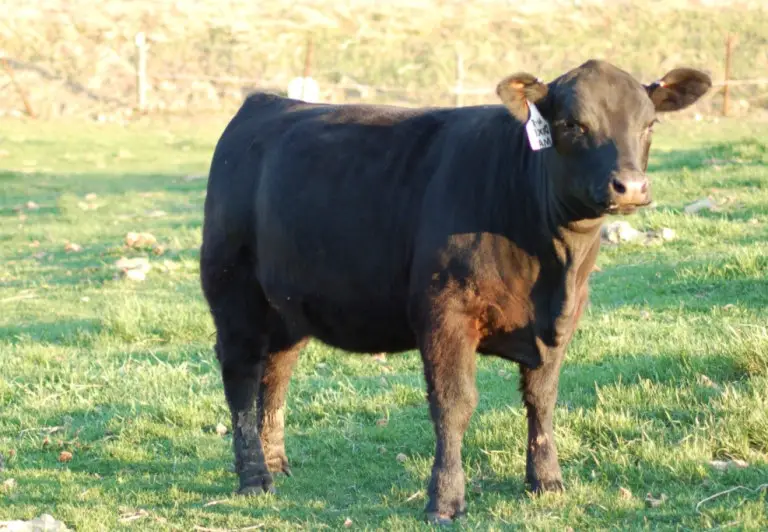No products in the cart.
Cow
Lowline Angus Cattle: Growth Rate, Meat Quality, And More
The Australian Lowline Angus breed is an excellent choice for small-scale farm owners who want to raise cows for beef but don’t have a lot of space for regular cows.
This article will provide information on this particular cow breed, including its size and height, growth rate, meat quality, and some questions related to it.
*This post may have affiliate links, which means I may receive commissions if you choose to purchase through links I provide (at no extra cost to you). As an Amazon Associate I earn from qualifying purchases. Please read my disclaimer for additional details.
What Is A Lowline Angus?
Lowline Angus (or Australian Lowline) is a small cattle breed that derives from cross-breeds with the Angus cattle. It is also part of a research project of the Triangle Agricultural Research Center in 1974 on the influence of the cow breed selection on its growth rate.
This cow breed originated from Australia and is widely raised on small acreages of all harsh weather conditions, including the hottest and the coldest areas. And it is becoming more and more popular because it is easy to raise and handle even for inexperienced farmers, young people, or older people.
Lowline Angus cattle are great foragers and suitable for intensive grazing farms. They are well-known for their remarkable feed-to-meat ratio.
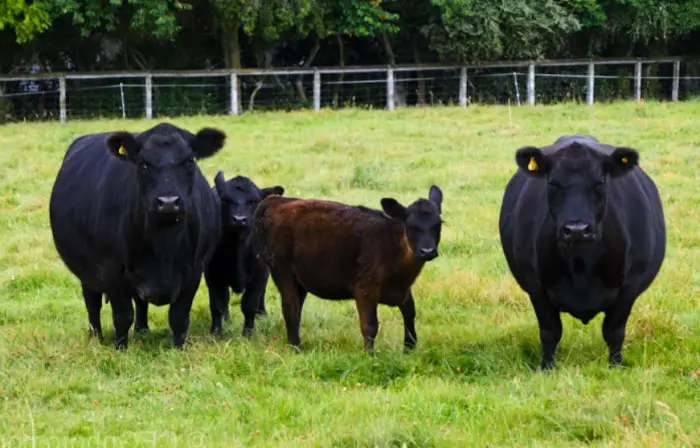
History of Lowline Angus Breed
The Lowline Angus breed was first developed in 1929 from a registered dwarf-free Aberdeen Angus herd established in the Trangie Research Center in Australia. The seed cattle to form the foundation of this herd were purchased from Canada, America, Scotland, and Australia. This experience provided high-quality cattle breeding stock for the New South Wales industry.
In 1963, the Australian Meat Research Center requested the Trangie Research Center to conduct a research project on the performance recording within a herd. This project ended in 1970, demonstrating the effectiveness of performance testing on the stud herd and initiating performance testing in Australia.
From 1974, further research on the relationship between the growth rate and herd profitability was conducted on the Lowline Angus breed. The aim of this research is to know whether large or small cows could convert grass to meat more efficiently.
In this research, the selected herds were Lowline, Highline, and Control Line, and they are evaluated based on several factors like weight gain, feed intake, carcass yield, milk production, reproductive performance, quality, and structural soundness. This research lasted 15 years, resulting in the matured Lowline being 30% smaller than the Highline cattle.
The interested cattlemen then brought the tested Lowline Angus from the disposal sale after the research, and in 1992, they formed the Australian Lowline Cattle Association (ALCA). The interest in the Lowline Angus breed has continued since then.
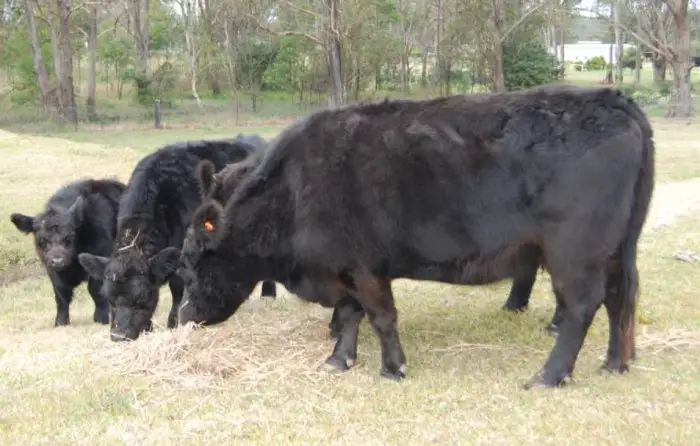
Lowline Angus Characteristics
1. Size & Height
The Lowline Angus looks similar to the British beef breed. A mature bull has a height of 100-110cm at the shoulder, while a mature female one has a smaller size of 95-105cm at the hip.
2. Weight & Growth rate
Newborn calves weigh approximately 45-53 pounds (20-24 kg). And from this time until they are 8 months old, they have a steady growth rate. They can double their birth weight within the first 6 weeks.
From 8 months old until the end of their toddler stage, heifers weigh around 240 pounds (110kg), reaching 418 pounds (190kg). Bulls weigh about 300 pounds (140kg), reaching 510 pounds (230kg).
These cattle become mature when they are 3 years old. At this age, cows have an average weight of 710 pounds (320kg), while bulls can reach over 880 pounds (400kg).
3. Life expectancy
The Lowline cattle breed has an average life expectancy of between 12 and 25 years.
They mature when they are 6-8 months, or over 9 months old. The puberty age of Lowline cows is from 6-15 months old, and that of bulls is later, from 9-10 months old.
4. Temper & Adaptivity
Lowline Angus cows are hard-working foragers that can be well-adapted to many different climates, from Canada to the deep South. They are easy to raise and require only 1/3 feed intake than larger breeds. Besides, they are an easy-going, quiet-tempered breed. They also don’t need high or strong fencing or be as destructive as larger cattle breeds.
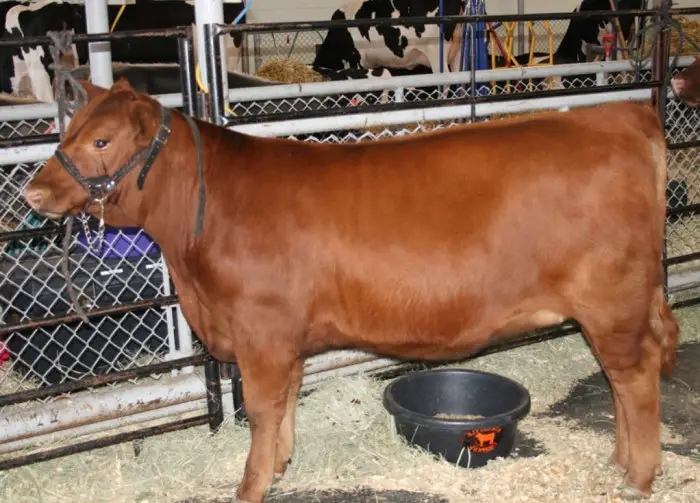
Lowline Angus Uses
The Lowline Angus are raised mainly for beef production.
First, the Lowline Angus provides the highest carcass field among many Lowline breeds like Wagyu, Hereford, Simmental, or Shorthorn. According to the data provided by the Trangie Research Center, a 100-acre farm of Lowline Angus cows can provide 203.1 pounds of meat per acre, 76% of which is saleable weight.
Conversely, these numbers for a Wagyu farm of Wagyu are only 151.1 pounds and 55%. In addition, a mature cow weighs around 900-1000 pounds, while a mature bull weighs 1200-1700 pounds.
Another reason this cow breed became more popular on small commercial farms is that it is easy to raise and calf with low feed intake and fencing costs. And since they require less feed than larger breeds (for instance, the regular Angus), they are highly advisable as the best converters from grass to meat.
This small cow breed provides super excellent beef quality, which can perfectly meet the requirements of the premium niche or specialty beef marketplace. Its meat tastes and looks good, has tenderness and is well-marbled.
This grass-fed beef is packed in smaller portions, which is a strong plus for consumers who are conscious about health.
Can you milk a Lowline Angus?
Although Lowline Angus can produce milk, they are not bred for milk and meat production like Dexter. In fact, they can only make an amount of enough milk to feed their kids.
Lowline Angus Breeding
Apart from their excellent meat, their ease of calving makes Lowline Angus an ideal choice for commercial farming on a small scale.
Indeed, this cow breed is also known to have high reproductive performance. Since they aren’t be affected by the Achondroplasia (dwarfism) gene, they calve easily with a low risk of abortion or genetically generated deformity.
Cows start their breeding age from 13-15 months old, while bulls start later from 1 year old. Heifers can only start their breeding cycle when they reach a required weight of approximately 220kg (at their 14-18 months of age). This physical characteristic of young cows minimizes unwanted conceiving while enabling farmers to manage their herd easier.
Lowline Angus cows have a short gestation period of only 271 days, which is relatively short compared to other larger breeds. While a female cow only produces one calf per time, there might sometimes be twins or even triplets. You can know precisely when the calf is due by using the gestation calculator.
They are known as great moms with excellent maternal instincts, have easy birth delivery in 12-16 hours with little to no birth issues. They can provide milk for their kids for up to 10 months (305 days). Between two breeding cycles, they often have a short rest of 60 days.
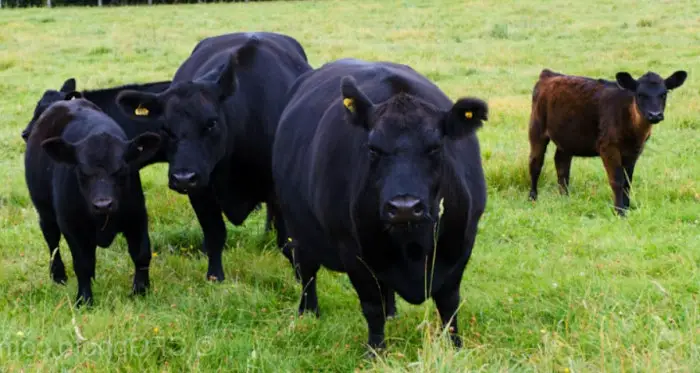
FAQs
1. Do Lowline Angus have horns?
Lowline Angus cows are naturally polled and have no horns.
2. Are Lowline cattle profitable?
Lowline cattle are highly profitable. They can provide excellent beef with 50% of their weight in the meat and 30% larger ribeye area per 100kg of weight. Their meat is tender and well-marbled.
3. How much does a Lowline Angus cost?
The price of a Lowline Angus varies depending on whether it is a full-blood, a purebred, a ¾, or a ½ blood. A full-blood one has the highest price while a ½ blood gets the lowest.
This price also depends on the cow’s gender, which is a female cow will cost higher than a bull. For example, a full-blood female can be selling at $633, while the selling price of a full-blood bull can be $271.
Final Words
After reading this article on Lowline Angus, you have understood that this cow breed is an affordable yet profitable choice for meat production on small farms. Their advantages, this breed now bred in many countries worldwide like Australia, Czech, Canada, New Zealand, the USA, and China.
